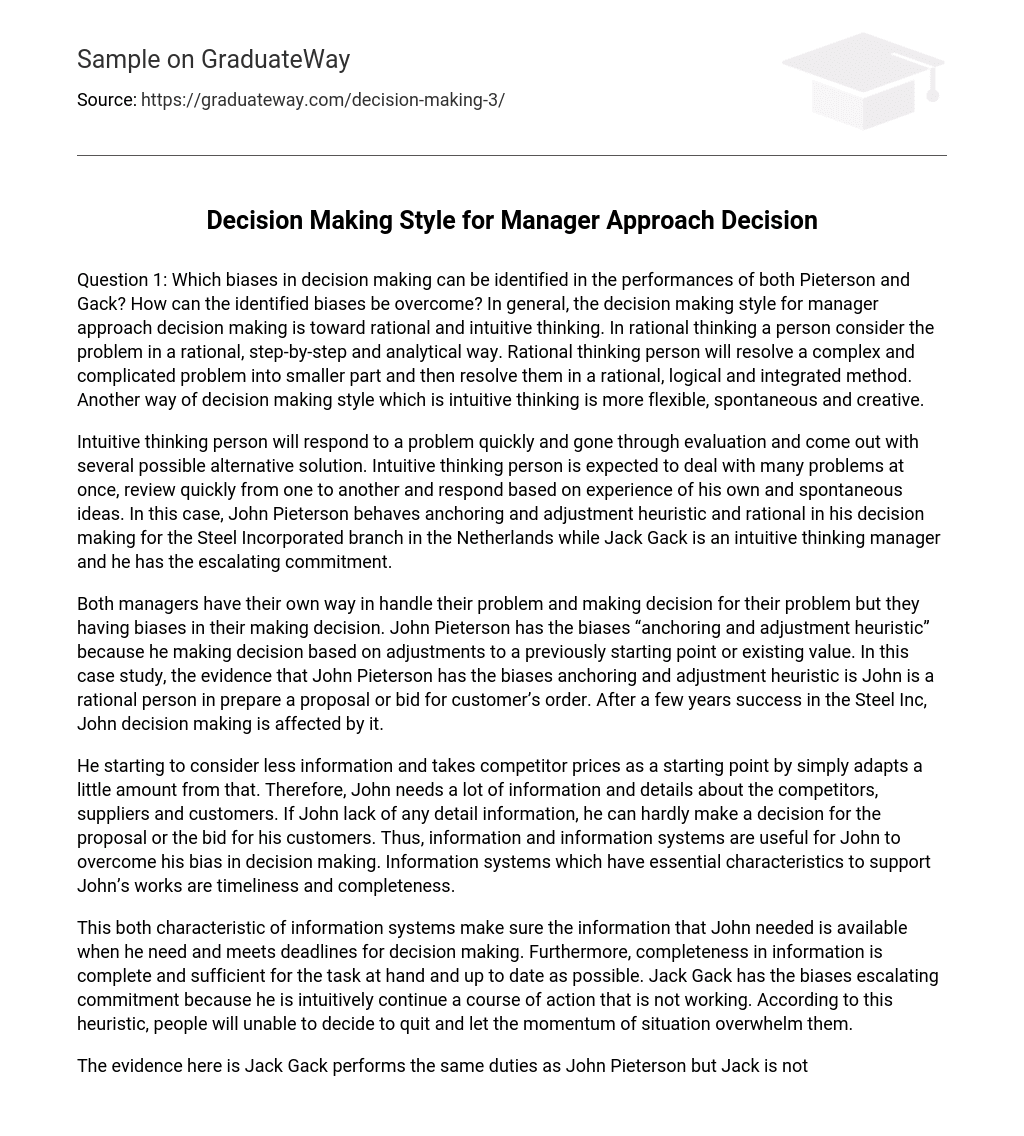Question 1: What biases exist in the decision making of Pieterson and Gack? How can these biases be overcome?
The decision making style for managers typically prioritizes rational and intuitive thinking. Rational thinking includes logical and analytical problem-solving, breaking down issues into smaller parts, and finding comprehensive solutions. In contrast, intuitive thinking is characterized by flexibility, spontaneity, and creativity.
An intuitive thinker is quick to respond to problems and evaluates them before coming up with multiple possible solutions. They are able to handle multiple problems at once, effortlessly transitioning from one to another based on their own experience and spontaneous ideas. In the case of John Pieterson, he demonstrates the use of anchoring and adjustment heuristic and rational decision-making for the Steel Incorporated branch in the Netherlands. On the other hand, Jack Gack is a manager who relies on intuitive thinking and exhibits escalating commitment.
Both managers have their own approach to handling problems and making decisions. However, they both exhibit biases in their decision-making processes. John Pieterson, in particular, displays the bias known as the “anchoring and adjustment heuristic.” This means that he tends to base his decisions on adjustments made to a starting point or an existing value. This bias is evident in a case study where John, a rational individual, prepares a proposal or bid for a customer’s order. It is apparent that his decision-making is influenced by his previous success at Steel Inc, as he relies on the anchoring and adjustment heuristic.
John has begun to rely less on information and instead uses competitor prices as a starting point, adjusting them slightly. As a result, he requires extensive information and specifics about competitors, suppliers, and customers. If John is lacking any necessary details, it becomes difficult for him to make decisions regarding proposals or bids for his customers. Therefore, having access to information and information systems is crucial for John to overcome his decision-making bias. Timeliness and completeness are key characteristics of information systems that support John in his work.
This combination of features guarantees that John can access the necessary information at exactly the right time, meeting decision-making deadlines. Moreover, the provided information is comprehensive and suitable for the task at hand, while also being as current as possible.
In addition, Jack Gack demonstrates the cognitive bias called escalating commitment, wherein he persistently pursues a particular course of action even when it proves ineffective. According to this heuristic, individuals may find it difficult to decide to quit and instead yield to the momentum of the situation.
Jack Gack performs the same duties as John Pieterson at the Steel Inc branch in Finland. However, Jack is not very successful in his role. He makes rational decisions but also incorporates intuition. Despite being frequently criticized, Jack is unwilling to discard his intuition in decision making. He attributes his lack of success to external factors and remains determined to hold onto his intuition throughout the decision-making process.
He is experiencing escalating commitment, which is when someone continues an action even if it is not effective. Therefore, Jack should not restrict himself to only one approach. Instead, Jack should establish clear boundaries for his involvement and commitment to a specific action. He should stick to these limits, make his own choices, and avoid blindly following the actions of others, as they may also fall into the trap of escalation. Jack should carefully assess the reasons for continuing an action, be mindful of the associated costs, and be aware of any tendencies for escalation.
In addition, it is recommended that Jack engages in further discussions with his employee or co-worker before making a final decision. This is because team decisions offer a wider range of information, knowledge, and expertise to effectively resolve issues. Furthermore, team decisions encourage the exploration of various alternatives, preventing any narrow focus or limited options. Therefore, incorporating team decisions will help Jack make more logical choices and prevent unnecessary escalation. Additionally, it is advised for Jack to regularly consult past references when making decisions concerning the current problem to avoid personal biases affecting his judgment.
In conclusion, rational thinking is important for decision making, but intuitive thinking allows for more flexibility and creativity. Both styles have strengths and weaknesses. Managers often show biases like “anchoring and adjustment heuristic” and “escalating commitment” due to cognitive limitations, risk, and uncertainty. However, these biases can actually help us make better decisions when facing complex environments, limited information, and cognitive limitations.





